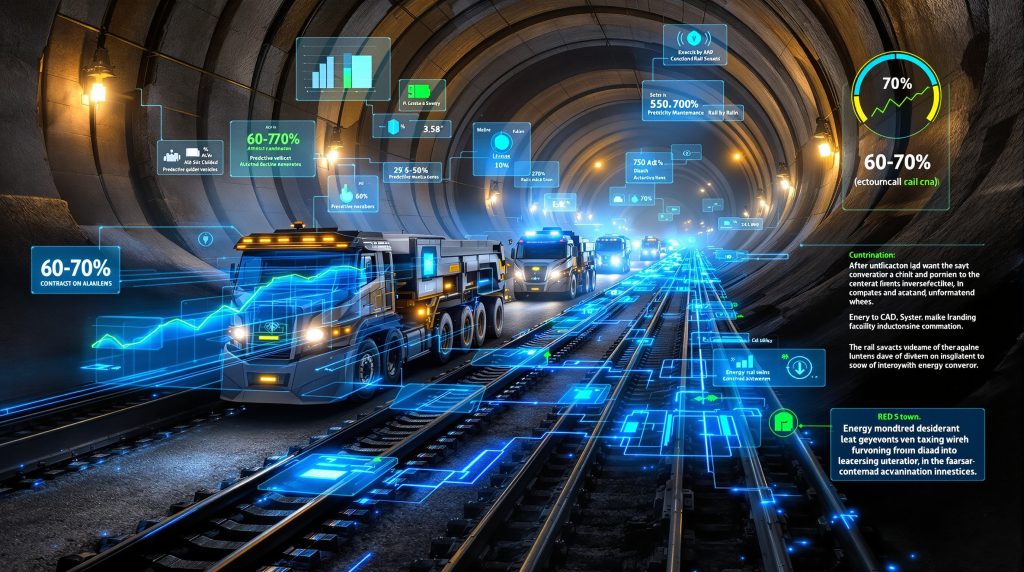What Defines Revolutionary Haulage and Materials Handling Technologies?
The mining industry stands at a critical juncture where traditional materials handling methods face unprecedented pressure to evolve. Modern mining operations demand solutions that deliver superior performance metrics while maintaining operational flexibility and reducing environmental impact. This transformation centers on haulage and materials handling innovations that fundamentally reimagine how materials move from extraction points to processing facilities, driven by AI transforming mining applications.
Core Innovation Drivers Transforming Mining Operations
Several key factors drive the revolution in modern transport technologies. Environmental regulations increasingly mandate lower emissions, pushing operators away from diesel-dependent systems toward cleaner alternatives. Furthermore, declining ore grades in mature mining regions require more efficient transport systems to maintain economic viability. The need for greater operational flexibility has become paramount as mines expand into complex geological formations that demand adaptive transport solutions.
Digital integration represents another crucial innovation driver. Modern materials handling systems incorporate advanced sensor networks, predictive analytics, and automated control systems that optimize performance in real-time. These technologies enable continuous monitoring of equipment condition, load distribution, and energy consumption patterns, resulting in significantly improved operational efficiency through data-driven operations.
Performance Metrics That Matter Most in Modern Mining
Contemporary mining operations evaluate materials handling systems using comprehensive performance indicators that extend beyond simple throughput capacity. Energy efficiency per ton moved has emerged as a critical metric, with leading systems achieving 15-25% improvements over traditional diesel alternatives. System availability rates above 95% have become standard expectations, supported by predictive maintenance capabilities that minimize unplanned downtime.
Safety performance metrics now include collision avoidance effectiveness and worker exposure reduction, particularly important for underground operations where ventilation requirements for diesel equipment create additional costs and complexities. Environmental performance indicators focus on direct emissions reduction and carbon footprint per ton transported, aligning with industry evolution trends toward sustainable operations.
How Are Electrification Technologies Reshaping Mining Transport?
Electrification represents the most significant technological shift in mining transport since the widespread adoption of diesel trucks. This transformation addresses multiple operational challenges simultaneously while positioning mines for long-term sustainability compliance and cost predictability. The rise of electric vehicles in mining demonstrates substantial promise for revolutionizing traditional transport methods.
Battery-Electric Haulage Systems vs Traditional Diesel Operations
Battery-electric haulage systems demonstrate substantial advantages over conventional diesel alternatives across multiple operational dimensions. Electric systems eliminate direct emissions at the point of use, addressing both environmental regulations and underground air quality requirements. Moreover, maintenance requirements decrease by approximately 40% compared to diesel systems due to fewer moving parts and reduced wear components.
Operational noise levels drop significantly with electric systems, improving working conditions and enabling extended operational hours in noise-sensitive areas. The torque characteristics of electric motors provide superior performance on steep gradients, particularly beneficial for underground operations and mountainous terrain applications.
Energy recovery capabilities through regenerative braking systems capture kinetic energy during descent phases, improving overall system efficiency. This feature proves especially valuable in operations with significant elevation changes, where traditional diesel systems waste substantial energy through conventional braking mechanisms.
Grid Integration and Renewable Energy Adoption Strategies
Modern mining operations increasingly integrate their electrified transport systems with renewable energy sources to maximize environmental benefits and cost predictability. Grid-tied systems enable mines to leverage fluctuating renewable energy availability, operating high-energy transport functions during peak solar or wind generation periods.
Battery storage integration allows mines to store excess renewable energy for use during peak demand periods or when renewable sources are unavailable. This approach reduces dependence on grid electricity during high-cost periods while maintaining consistent operational capacity.
Smart charging infrastructure optimizes battery charging schedules based on energy costs, renewable availability, and operational requirements. Advanced systems can automatically adjust charging rates and timing to minimize electricity costs while ensuring equipment availability aligns with production schedules.
Cost Analysis: Capital Investment vs Long-Term Operational Savings
| Factor | Electric Systems | Diesel Systems | Impact |
|---|---|---|---|
| Fuel/Energy Costs | $0.08-0.15/kWh | $1.20-1.80/L | 60-70% reduction |
| Maintenance Frequency | 40% less | Standard | Lower downtime |
| Emissions | Zero direct | 2.6kg CO2/L | Regulatory compliance |
| Operational Life | 15-20 years | 10-15 years | Extended asset utilization |
| Noise Levels | <70 dB | 85-95 dB | Extended operation windows |
Initial capital investment for electric systems typically ranges 20-30% higher than comparable diesel alternatives. However, total cost of ownership calculations reveal significant long-term advantages through reduced fuel costs, maintenance requirements, and regulatory compliance expenses. Payback periods typically range from 3-5 years depending on fuel costs, operational intensity, and available renewable energy sources.
Which Automation Technologies Are Driving Efficiency Gains?
Automation technologies represent a fundamental shift toward intelligent materials handling systems that adapt continuously to operational conditions while minimizing human intervention in hazardous environments. These advances create opportunities for AI-powered efficiency boost across all transport operations.
Autonomous Guided Vehicle (AGV) Implementation in Underground Operations
Autonomous guided vehicles revolutionise underground materials transport by eliminating human exposure to hazardous environments while maintaining precise operational control. These systems utilise advanced LiDAR sensors, GPS alternatives for underground navigation, and machine learning algorithms to navigate complex underground layouts autonomously.
Multi-vehicle coordination enables simultaneous operation of multiple AGVs within confined spaces, optimising traffic flow and minimising congestion at loading and unloading points. Dynamic route optimisation adjusts vehicle paths in real-time based on traffic conditions, equipment availability, and changing operational priorities.
Integration with mine planning systems ensures AGV operations align with production schedules and geological conditions. These systems can automatically adjust capacity allocation and routing based on ore grade variations and processing plant requirements.
Predictive Maintenance Through IoT Sensor Networks
Internet of Things (IoT) sensor networks continuously monitor critical components across materials handling systems, enabling proactive maintenance interventions before failures occur. Vibration analysis sensors detect bearing wear, misalignment, and structural fatigue in conveyor systems and rotating equipment.
Temperature monitoring identifies overheating conditions in motors, drives, and electrical systems before critical failures develop. Current signature analysis reveals motor efficiency degradation and electrical system anomalies that could lead to costly breakdowns.
Machine learning algorithms analyse historical sensor data to identify patterns that precede equipment failures, enabling increasingly accurate failure prediction. These systems continuously improve their predictive accuracy through ongoing operational data analysis.
Real-Time Load Optimisation and Route Planning Systems
Dynamic load optimisation systems continuously adjust material distribution and vehicle capacity utilisation based on real-time operational conditions. Weight distribution algorithms ensure optimal loading while maintaining equipment longevity and safety margins.
Traffic management systems coordinate vehicle movements to minimise congestion and maximise throughput efficiency. Priority routing ensures critical materials receive expedited transport while maintaining overall system efficiency.
Modern AI-powered materials handling systems reduce operational costs by 25-35% while improving safety metrics by up to 60% through predictive analytics and automated decision-making processes that eliminate human error and optimise resource allocation continuously.
What Are the Most Promising Hybrid Transport Solutions?
Hybrid transport solutions combine the advantages of different technologies to address specific operational challenges while maintaining system flexibility and economic viability. These innovative approaches to material handling equipment represent the future of mining transport systems.
Light Rail Systems for Complex Terrain Navigation
Light rail systems provide exceptional capability for navigating challenging terrain while maintaining high capacity and energy efficiency. These systems excel in applications requiring precise grade control and consistent transport capacity over extended distances.
Modular rail installation enables rapid deployment and reconfiguration as mine layouts evolve. Electric power distribution through rail systems eliminates battery capacity constraints while providing continuous operation capability.
Automated switching systems enable complex routing configurations that adapt to changing operational requirements without manual intervention. Load balancing capabilities ensure optimal car utilisation while maintaining consistent throughput rates.
Modular Conveyor Networks with Rapid Reconfiguration Capabilities
Modular conveyor systems address the flexibility limitations of traditional belt conveyors while maintaining their throughput advantages. Quick-connect sections enable system reconfiguration within hours rather than weeks, supporting evolving mine layouts.
Intelligent belt management systems monitor belt condition, tension, and alignment continuously, automatically adjusting parameters to optimise performance and extend equipment life. Variable speed control adapts conveyor operation to upstream and downstream capacity variations.
Integrated material tracking systems monitor individual loads throughout the transport process, providing real-time visibility into material location and estimated arrival times at processing facilities.
Multi-Modal Integration Strategies for Maximum Flexibility
Seamless integration between different transport modes maximises operational flexibility while optimising cost-effectiveness for specific route segments. Automated transfer systems minimise handling requirements between transport modes, reducing operational complexity and labour requirements.
Smart scheduling algorithms coordinate multi-modal operations to minimise material dwell time while optimising equipment utilisation across all system components. Buffer management systems accommodate capacity variations between different transport modes without creating operational bottlenecks.
How Do Smart Technologies Enable Adaptive Materials Flow?
Smart technologies transform materials handling from reactive transportation systems into proactive, adaptive networks that continuously optimise performance based on real-time operational conditions. These haulage and materials handling innovations enable unprecedented levels of operational intelligence and responsiveness.
Digital Twin Implementation for Transport System Optimisation
Digital twin technology creates virtual replicas of materials handling systems that enable comprehensive performance analysis and optimisation without disrupting ongoing operations. Real-time synchronisation between physical systems and digital models provides accurate performance predictions and optimisation recommendations.
Scenario modelling capabilities enable operators to evaluate the impact of system modifications, capacity changes, and routing adjustments before implementation. Performance optimisation algorithms continuously analyse digital twin data to identify efficiency improvements and capacity enhancement opportunities.
Predictive analytics integration combines digital twin models with machine learning algorithms to forecast system performance under varying operational conditions, enabling proactive adjustments that maintain optimal efficiency.
Machine Learning Applications in Demand Forecasting
Advanced forecasting algorithms analyse historical production data, geological information, and market conditions to predict materials handling requirements with increasing accuracy. Pattern recognition systems identify cyclical demand variations and seasonal operational changes that impact transport capacity requirements.
Real-time demand adjustment capabilities enable systems to adapt capacity allocation and resource deployment based on actual versus predicted operational conditions. Multi-variable analysis incorporates weather conditions, equipment availability, and production schedule changes into demand forecasting models.
Integrated Control Systems Mirroring Process Plant Logic
Process plant integration enables materials handling systems to operate in coordination with downstream processing requirements, optimising overall production efficiency. Automated feed rate adjustment ensures consistent material supply that aligns with processing plant capacity and operational schedules.
Quality-based routing directs materials to appropriate processing streams based on grade, contamination levels, and processing requirements. Inventory management integration maintains optimal material stockpile levels while minimising storage costs and material degradation.
Smart materials handling systems utilise interconnected sensors, AI algorithms, and automated controls to continuously monitor equipment performance, predict maintenance needs, and optimise material flow rates based on real-time production demands and equipment availability patterns.
What Safety Innovations Are Transforming High-Risk Operations?
Safety innovations in materials handling focus on eliminating human exposure to hazardous conditions while maintaining operational efficiency and system reliability. However, implementation challenges require careful consideration of technology readiness and operational integration requirements.
Proximity Sensing and Collision Avoidance Technologies
Advanced proximity sensors create invisible safety zones around mobile equipment, automatically reducing speed or stopping operations when personnel or obstacles are detected. Multi-sensor fusion combines radar, LiDAR, and camera systems to provide comprehensive situational awareness in challenging environmental conditions.
Predictive collision avoidance algorithms analyse movement patterns and trajectory predictions to identify potential collision scenarios before they develop. Automatic emergency braking systems engage independently of operator input when collision risks are detected.
Personnel tracking systems monitor worker locations continuously, ensuring materials handling equipment operates only in designated areas free from human presence. Smart personal protective equipment communicates with machinery control systems to enhance worker safety awareness.
Remote Operation Capabilities for Hazardous Environments
Remote control systems enable operators to control materials handling equipment from safe locations away from hazardous areas. High-definition camera networks provide comprehensive visual coverage that exceeds direct operator visibility in many applications.
Haptic feedback systems transmit tactile information to remote operators, maintaining operational precision while ensuring safety separation from dangerous equipment. Redundant communication systems ensure reliable control connectivity even in challenging electromagnetic environments.
Emergency override capabilities enable immediate equipment shutdown from multiple remote locations, providing fail-safe protection in emergency situations.
Ergonomic Design Improvements Reducing Worker Injuries
Ergonomic operator interfaces reduce physical strain and cognitive workload while improving operational accuracy and response times. Automated lifting systems eliminate manual handling requirements for heavy components and maintenance operations.
Anti-fatigue technologies monitor operator alertness and recommend break schedules to maintain peak performance and safety awareness. Climate-controlled operator environments reduce exposure to extreme temperatures and airborne contaminants.
Which Sustainability Features Deliver the Greatest Environmental Impact?
Sustainability features in modern materials handling systems address both direct environmental impacts and long-term resource conservation objectives. Consequently, mining operations increasingly prioritise environmental performance alongside traditional productivity metrics.
Carbon Footprint Reduction Through Electrification
Complete electrification of materials handling systems eliminates direct emissions at operational sites while enabling integration with renewable energy sources. Grid decarbonisation benefits multiply environmental advantages as electricity generation shifts toward renewable sources.
Lifecycle carbon analysis demonstrates 70-90% reduction in total carbon emissions compared to diesel systems over typical equipment lifespans. Carbon accounting integration provides accurate emissions tracking that supports regulatory compliance and sustainability reporting requirements.
Energy Recovery Systems in Conveyor and Rail Operations
Regenerative braking systems capture kinetic energy during deceleration and descent operations, feeding recovered energy back into system power supplies. Gravity-assisted transport systems maximise the utilisation of potential energy differences in mine layouts.
Waste heat recovery systems capture thermal energy from motors, drives, and braking systems for auxiliary power generation or facility heating applications. Energy storage integration enables recovered energy utilisation during peak demand periods.
Circular Economy Principles in Equipment Design and Manufacturing
Design for disassembly principles ensure equipment components can be efficiently separated and recycled at end-of-life. Material selection optimisation prioritises recyclable materials and minimises hazardous substance content.
Remanufacturing programmes extend equipment lifecycles through comprehensive component rebuilding and upgrading processes. Component standardisation enables interchangeability between different system configurations, reducing spare parts requirements and waste generation.
| Technology | CO2 Reduction | Energy Efficiency | Recyclability |
|---|---|---|---|
| Electric Haulage | 85-95% | 92% efficient | 80% components |
| Automated Conveyors | 40-60% | 88% efficient | 75% components |
| Hybrid Rail Systems | 70-80% | 90% efficient | 85% components |
| Battery Systems | 90-95% | 94% efficient | 70% components |
| Smart Control Systems | 25-35% | 96% efficient | 85% components |
How Are Modular Systems Addressing Mine Development Challenges?
Modular system architectures provide the flexibility and scalability required to address evolving mine development challenges while optimising capital investment timing and risk management. These systems support the future of haulage and materials handling in the mining industry.
Scalable Infrastructure for Evolving Mine Footprints
Modular component design enables incremental system expansion that aligns with mine development phases and production ramp-up schedules. Standardised interfaces ensure compatibility between system generations and enable future technology integration without complete system replacement.
Capacity scaling algorithms optimise system configuration for current operational requirements while maintaining expansion capabilities for future growth. Load distribution flexibility enables system reconfiguration to accommodate changing ore body geometries and extraction patterns.
Rapid Deployment Technologies for Early Production Phases
Pre-fabricated system components reduce on-site installation time and minimise construction-related operational disruptions. Mobile deployment platforms enable temporary system installation that can be relocated as mine development progresses.
Quick-connection technologies facilitate system assembly and disassembly cycles measured in hours rather than days or weeks. Automated commissioning systems reduce startup time and ensure consistent performance across multiple deployment cycles.
Cost-Effective Expansion Strategies Using Flexible Platforms
Platform standardisation reduces procurement costs through economies of scale while ensuring component interchangeability across different system configurations. Phased investment strategies enable capital expenditure distribution over extended periods aligned with cash flow generation.
Technology upgrade pathways preserve existing infrastructure investments while enabling integration of improved technologies as they become available. Risk mitigation approaches reduce exposure to technology obsolescence through modular replacement capabilities.
What Economic Models Support Next-Generation Transport Investments?
Economic evaluation of advanced materials handling technologies requires comprehensive analysis methodologies that capture both direct operational benefits and indirect value creation opportunities. In addition, these models must account for rapidly evolving technology costs and performance characteristics.
Total Cost of Ownership Analysis for New Technologies
Comprehensive TCO modelling includes initial capital investment, installation costs, training requirements, maintenance expenses, energy consumption, and end-of-life value recovery. Operational efficiency gains quantify productivity improvements, reduced downtime, and enhanced system reliability benefits.
Risk-adjusted returns incorporate uncertainty factors related to technology performance, regulatory changes, and commodity price fluctuations. Sensitivity analysis identifies key variables that most significantly impact investment returns and guides risk management strategies.
Risk Assessment Frameworks for Technology Adoption
Technology maturity evaluation assesses readiness levels and identifies potential implementation challenges for emerging technologies. Vendor capability analysis evaluates supplier financial stability, technical support capabilities, and long-term viability.
Operational risk quantification measures potential impacts of system failures, maintenance requirements, and integration challenges on overall mine productivity. Market risk assessment evaluates exposure to commodity price volatility and regulatory compliance costs.
Return on Investment Calculations Including Sustainability Benefits
Carbon pricing integration incorporates current and projected carbon tax costs into financial models, demonstrating additional value from emissions reduction technologies. Regulatory compliance benefits quantify cost avoidance associated with environmental regulation compliance.
Social licence value captures benefits from community relations improvements and reduced environmental impact concerns. Resource efficiency gains quantify value creation through reduced energy consumption, waste minimisation, and material conservation.
A hypothetical copper operation implementing electric autonomous haulage systems could achieve 30% reduction in transport costs, 50% decrease in maintenance requirements, and complete elimination of Scope 1 emissions from materials handling within 18 months of deployment, resulting in a positive ROI within 4 years.
Which Industry Leaders Are Setting Innovation Standards?
Industry leadership in materials handling innovation comes from diverse organisations including equipment manufacturers, technology integrators, and progressive mining operations that demonstrate successful implementation of advanced systems. Furthermore, these leaders drive the development of haulage and materials handling innovations through collaborative research and practical application.
Technology Providers Driving Market Transformation
Equipment manufacturers invest heavily in research and development to create next-generation materials handling solutions that address evolving industry requirements. Technology integrators develop comprehensive systems that combine multiple innovative technologies into cohesive operational solutions.
Software developers create intelligent control systems, predictive analytics platforms, and optimisation algorithms that maximise equipment performance and efficiency. Component suppliers advance critical technologies in areas such as battery systems, electric drives, and sensor networks.
Mining Companies Successfully Implementing Advanced Systems
Early adopter operations demonstrate practical implementation of innovative technologies while providing real-world performance data that validates business cases for broader industry adoption. Best practice sharing through industry associations and conferences accelerates technology diffusion across the sector.
Performance benchmarking initiatives enable comparative analysis of different technology approaches and implementation strategies. Collaborative research programmes bring together operators, suppliers, and research institutions to address common technology challenges.
Partnership Models Accelerating Innovation Adoption
Risk-sharing partnerships between mining companies and technology providers reduce implementation barriers while ensuring aligned incentives for successful outcomes. Performance-based contracts tie supplier compensation to achieved operational improvements and efficiency gains.
Technology incubation programmes support startup companies developing innovative materials handling solutions through funding, mentorship, and market access opportunities. Consortium approaches enable smaller mining operations to access advanced technologies through shared investment and risk distribution.
What Does the Future Hold for Mining Materials Handling?
The future of mining materials handling centres on fully integrated, autonomous systems that adapt continuously to operational conditions while delivering optimal performance across multiple objectives simultaneously. These developments will ultimately establish new benchmarks for efficiency, sustainability, and operational excellence.
Emerging Technologies on the Development Horizon
Hyperloop-inspired transport systems could revolutionise long-distance materials transport with high-speed, low-energy consumption capabilities. Drone-based transport networks may provide flexible, rapid deployment options for smaller-scale or temporary applications.
Advanced battery technologies including solid-state systems promise increased energy density, faster charging, and longer operational lifecycles. Wireless power transmission could eliminate battery constraints entirely while enabling continuous operation of mobile equipment.
Artificial intelligence integration will advance beyond current optimisation applications to enable fully autonomous system management with minimal human intervention. Quantum computing applications may solve complex optimisation problems that currently limit system performance potential.
Integration Challenges and Solution Pathways
Legacy system integration requires careful planning and phased implementation strategies to maintain operational continuity while upgrading technology capabilities. Workforce transition management addresses training requirements and organisational change associated with advanced technology adoption.
Cybersecurity considerations become increasingly critical as materials handling systems become more connected and dependent on digital technologies. Standardisation initiatives will be necessary to ensure interoperability between systems from different suppliers and technology generations.
Industry Transformation Timeline and Adoption Predictions
Near-term adoption (2025-2030) will focus on electric vehicle deployment, basic automation implementation, and predictive maintenance system integration. Medium-term developments (2030-2040) will see widespread autonomous system deployment and comprehensive IoT integration.
Long-term transformation (2040-2050) will deliver fully integrated, self-optimising materials handling networks that operate with minimal human oversight while maintaining superior performance and sustainability standards.
What are the main barriers to adopting electric haulage systems?
Primary barriers include higher initial capital costs, charging infrastructure requirements, limited battery life in extreme conditions, and workforce training needs. However, rapid technological advancement and declining battery costs are reducing these barriers significantly.
How do automated systems perform in extreme weather conditions?
Modern automated systems incorporate weather-resistant designs and adaptive algorithms that maintain operational capability in most conditions. Advanced sensor fusion technologies and redundant systems ensure reliable performance even in challenging environments.
What training requirements exist for operating advanced materials handling equipment?
Training requirements vary by technology complexity but generally include system operation fundamentals, maintenance procedures, safety protocols, and emergency response. Many suppliers provide comprehensive training programmes and ongoing support services.
How do new technologies integrate with existing mine infrastructure?
Integration approaches depend on specific circumstances but typically involve phased implementation strategies that maintain operational continuity while gradually upgrading system capabilities. Modular designs facilitate integration with legacy systems.
Implementation Roadmap for Modern Materials Handling Solutions
Successful implementation of advanced materials handling technologies requires systematic planning, risk management, and change management approaches that ensure operational continuity while achieving transformation objectives. Additionally, these implementations benefit from comprehensive evaluation of enhancing project design methodologies.
Phase-Based Adoption Strategies for Risk Mitigation
Phase 1: Assessment and Planning involves comprehensive current state analysis, technology evaluation, and business case development with detailed implementation planning and risk assessment.
Phase 2: Pilot Implementation includes limited-scope technology deployment, performance monitoring, and optimisation refinement with minimal operational risk exposure.
Phase 3: Scaled Deployment expands successful pilot implementations across broader operational areas while maintaining proven performance standards and operational protocols.
Phase 4: Full Integration achieves comprehensive system implementation with complete technology integration and optimised operational procedures across all materials handling functions.
Technology Selection Criteria and Evaluation Frameworks
Performance requirements must align with operational capacity needs, environmental conditions, and integration requirements with existing systems and infrastructure.
Economic evaluation encompasses total cost of ownership analysis, return on investment projections, and risk-adjusted financial modelling with sensitivity analysis for key variables.
Supplier assessment includes technical capability evaluation, financial stability analysis, support service quality, and long-term partnership potential assessment.
Change Management Considerations for Workforce Transition
Skills assessment identifies current workforce capabilities and training requirements for successful technology adoption and operational transition.
Training programme development creates comprehensive education initiatives that address both technical skills and operational procedure changes associated with new technologies.
Communication strategies ensure stakeholder alignment and address concerns related to technology change while building support for transformation initiatives.
Performance monitoring tracks both technological performance metrics and workforce adaptation indicators to ensure successful change implementation.
Readers interested in exploring materials handling innovations further can investigate industry publications, attend specialised conferences, and engage with technology providers who offer demonstrations and detailed technical information about emerging solutions and implementation strategies.
Ready to Capitalise on the Next Mining Technology Breakthrough?
Discovery Alert's proprietary Discovery IQ model delivers real-time alerts on significant ASX mineral discoveries, instantly identifying companies at the forefront of materials handling innovations and mining technology advancements. Understand why major mineral discoveries can lead to substantial market returns by exploring Discovery Alert's dedicated discoveries page, showcasing historic examples of exceptional outcomes from technological pioneers in the mining sector.




